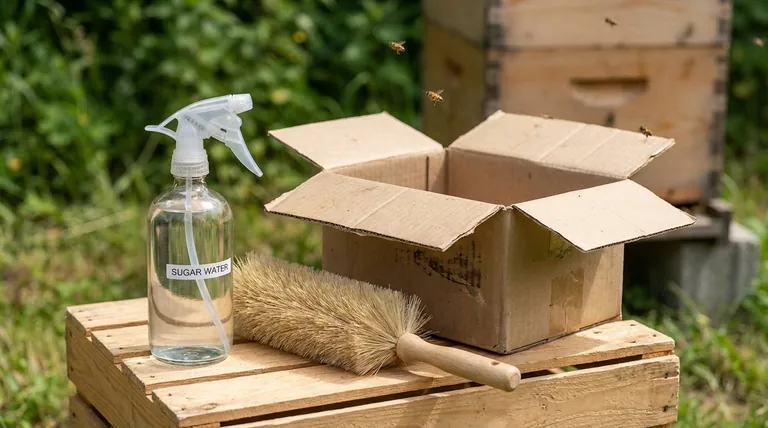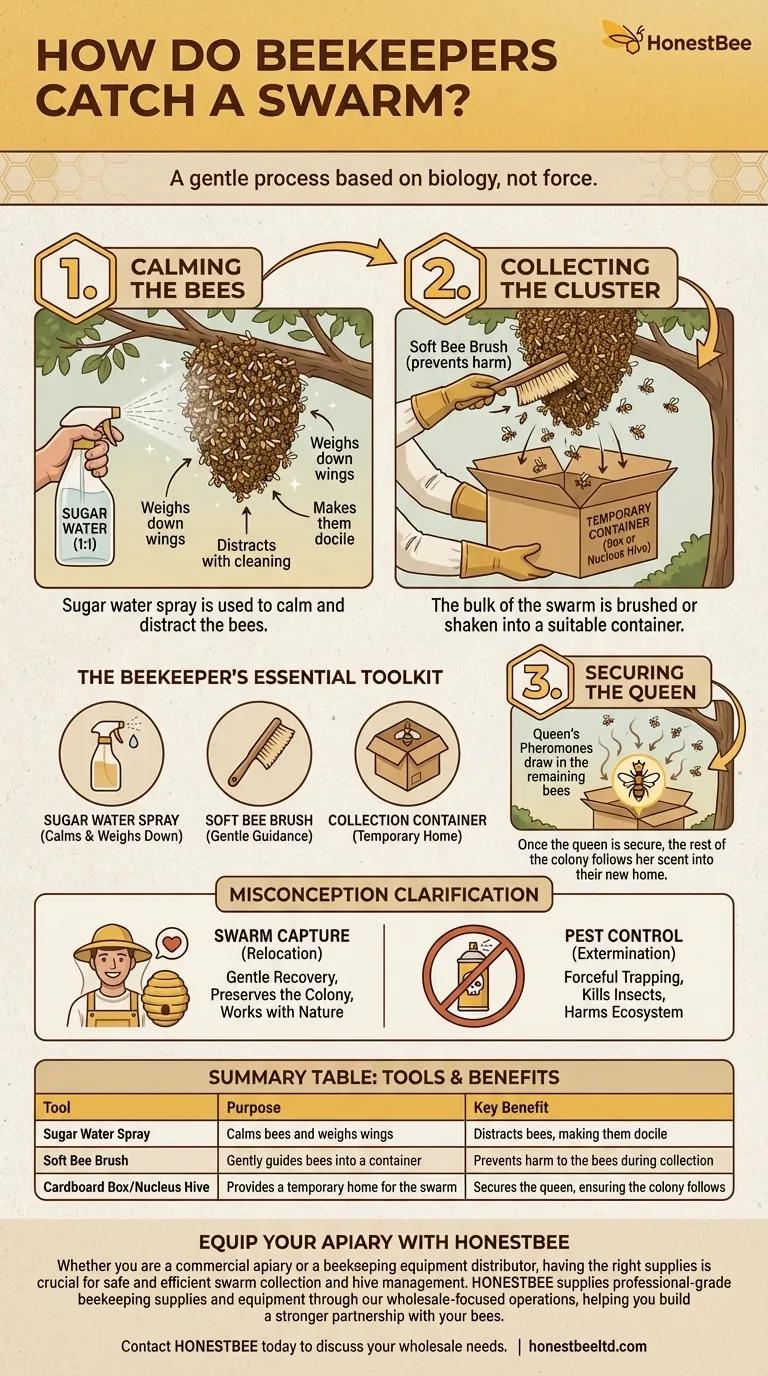The primary tools beekeepers use to catch bees are surprisingly simple: a spray bottle of sugar water, a soft bee brush, and a suitable container like a cardboard box or a nucleus hive. The goal is not to trap the bees, but to calmly persuade the entire cluster, led by their queen, to relocate.
Catching a swarm of bees is less about force and more about understanding their biology. The entire process hinges on one principle: secure the queen, and the rest of the colony will follow her into their new home.

The Core Technique for Capturing a Swarm
The process of catching a swarm is methodical and designed to be as low-stress as possible for both the beekeeper and the bees. Swarming bees are typically docile, as they have filled up on honey and have no hive to defend.
Step 1: Calming the Bees
The first step is to lightly spray the cluster of bees with a 1:1 sugar water solution. This has two immediate effects.
First, it weighs down their wings slightly, discouraging them from taking flight. Second, it gives them a task; they immediately begin cleaning the sweet liquid off themselves and each other, which distracts them from the beekeeper's presence.
Step 2: Collecting the Cluster
With the bees occupied, the beekeeper places an open box or container directly under the swarm. The cluster is then gently brushed or shaken into the box.
A soft-bristled bee brush is used to avoid harming any of the bees during this process. The goal is to get the bulk of the swarm, and most importantly the queen, into the container.
Step 3: Securing the Queen
The queen is almost always located in the dense center of the swarm. Once she is safely in the box, the job is mostly done.
The remaining bees in the air or on the original surface will quickly sense the queen's pheromones coming from the new container. Over the next several minutes, they will march directly into the box to join her.
Understanding the Beekeeper's Toolkit
While the process is straightforward, the tools are chosen specifically for the safety and well-being of the bees and the keeper.
Swarm Collection vs. Hive Management
It's crucial to distinguish between tools for catching a swarm and tools for managing a hive. Feeders and screened bottom boards, for example, are components of a permanent hive.
These are used to provide nourishment (like sugar syrup) and ventilation to a colony after it has been successfully housed, not to attract or catch them in the wild.
The Misconception of "Traps"
When beekeepers talk about catching bees, they are referring to the gentle collection of a swarm that has temporarily settled on a branch or structure. This is a recovery and relocation effort.
This is fundamentally different from pest control traps designed to kill insects. Beekeepers value the swarm and aim to preserve the entire colony.
Making the Right Choice
Your approach depends entirely on your situation and goals.
- If you see a swarm on your property: Your goal is safe removal. Do not spray them with pesticides; contact a local beekeeping association or club to find someone who will gladly collect them for free.
- If you are an aspiring beekeeper: Your goal is to learn proper technique. Focus on gentle handling and understanding that swarm capture is about calmly relocating a colony, not forcefully trapping it.
- If you are simply curious: The key is to recognize that beekeepers are essentially bee guardians. Their tools and methods are designed to work with the bees' natural instincts.
Ultimately, the capture process is a perfect illustration of the beekeeper's partnership with their bees.
Summary Table:
| Tool | Purpose | Key Benefit |
|---|---|---|
| Sugar Water Spray | Calms bees and weighs wings | Distracts bees, making them docile |
| Soft Bee Brush | Gently guides bees into a container | Prevents harm to the bees during collection |
| Cardboard Box/Nucleus Hive | Provides a temporary home for the swarm | Secures the queen, ensuring the colony follows |
Ready to equip yourself for successful beekeeping?
Whether you are a commercial apiary or a beekeeping equipment distributor, having the right supplies is crucial for safe and efficient swarm collection and hive management. HONESTBEE supplies professional-grade beekeeping supplies and equipment through our wholesale-focused operations, helping you build a stronger partnership with your bees.
Contact HONESTBEE today to discuss your wholesale needs and enhance your beekeeping practice.
Visual Guide

Related Products
- HONESTBEE Advanced Ergonomic Stainless Steel Hive Tool for Beekeeping
- Professional Dual-End Stainless Steel Hive Tool for Beekeeping
- Professional 3-Bar Frame Grip with Integrated Hive Tool
- Beehive Handle and Frame Rest Cutting Machine: Your Specialized Hive Machine
- No Grafting Queen Rearing Kit: System for Royal Jelly Production and Queen Rearing
People Also Ask
- Why do hive tools have a hole? Unlock the Secret to Efficient Beekeeping
- How should beekeepers handle bees when using a hive tool? Master Calm, Deliberate Techniques
- Why is it important to compare the progress of different hives? A Beekeeper's Key Diagnostic Tool
- What tools are used for cleaning frames? A Beekeeper's Simple 4-Tool Guide
- What are the basic tools for beekeeping? Essential Starter Kit for Safe & Successful Hive Management



















